Evaluation of the Residual Efficacy of Commercial Slug Baits
ID
ENTO-178NP (ENTO-401NP)
Introduction
Slugs are prevalent pests in no-till and reduced-till crop systems in Virginia. These slimy mollusks utilize plant residue to hide during the day, and at night, they feed on numerous crops causing irregular feeding holes and shredded leaves. Slugs cause the most damage during early plant growth. More information on slugs in Virginia and their management can be found in the VCE factsheets by Clark et al. (2008) and Jordan et al. (2009). Molluscicide baits that include the active ingredient metaldehyde (i.e., Deadline) are recommended as the best option for controlling damaging slug populations. More recently, baits containing iron phosphate have also demonstrated efficacy; some of these bait products include Sluggo® and Iron Fist®. In 2015, we evaluated the residual efficacy of three commercial baits, Iron Fist (2% iron phosphate), Deadline MP (4% metaldehyde), and Deadline GT (3% metaldehyde), applied in a no-till corn field near Blacksburg, VA.
Experiment
Materials and Methods
Sweet corn (‘Applause’) was planted following no- till practices on 19 May, 2015 into a heavy residue of late killed annual rye at Virginia Tech’s Kentland Farm. On 29 May, slug baits were applied into individual plots of seedling corn three rows wide by 20 ft long. The slug baits used were: Deadline MP 20 lb/a, Deadline GT 13.3 lb/a, and Iron Fist 10 lb/a. A control treatment of cat litter was also applied at a rate of 10 lb/a.
After 1 week in the field, which included 7/8 inch of rain on the night of 29 May and ½ inch of rain on 5 June, the bait conditions were evaluated and the baits collected for use in a lab bioassay (see below). The condition of the two Deadline baits were similar in that the granules were slightly cracking, but intact with original bait color still apparent. Conversely, most of the Iron Fist granules were completely disintegrated after 1 week.
Bioassay 1: Potted corn seedling with 1 week old baits
Baits that had been placed in field and exposed to natural field conditions for a week were brought back to lab. 1 g of each bait was placed in a 6-inch diameter by 6-inch-tall standard greenhouse pot. Each pot had 6 corn seedlings growing in standard potting soil. Over one hundred dusky slugs (Arion subfuscus) (Fig. 1), were field collected from gardens and grassy areas in Blacksburg, VA and brought back to the lab. Six or seven slugs were placed in each potted corn container and screen mesh was placed around the pot to contain slugs (Fig. 2). Each bait had 4 containers totaling approximately 25 slugs per bait treatment.
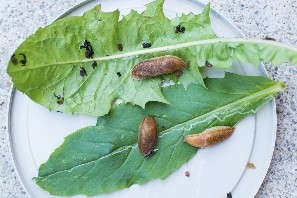
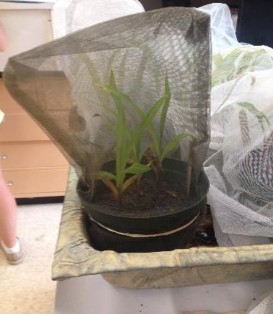
Results
After 48 hrs, all three baits, the Iron Fist 2%, Deadline MP 4%, and Deadline GT 3% resulted in about 50% mortality of slugs compared with the untreated control that averaged 15% mortality (Fig. 3). We observed very little feeding on the corn plant in this bioassay, which prompted us to try a different approach in Bioassay 2. We felt that the ambient conditions from a mesh bag over a potted plant (Fig. 2) may have been too dry in this assay. Also, the lack of feeding on the corn plants prompted us to try a different plant (dandelion) that we had observed the field-collected slugs feeding on.
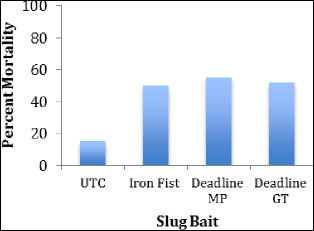
Bioassay 2: Two-week old baits in plastic bag
In this bioassay, two-week old baits were collected from the field, and 1 g of each bait was placed in plastic sandwich bags that were 16.5 x 8.2 cm. These bags were filled half way with potting soil and moistened daily. A fresh dandelion leaf was placed in each bag as a food source for slugs. Fresh bait was loaded into separate bags in the same manner to be used as comparison against the field exposed bait. Each bait had four bags containing 5 slugs totaling 20 slugs per bait treated (Fig 4). At the end of this assay, dandelion leaves were removed and feeding damage was photographed.
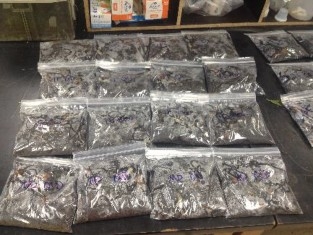
Results
The plastic sandwich bags created a high humidity environment, and the mortality of slugs in the control bag was negligible (Fig. 5). After 72 h, mortality was highest in the Iron Fist fresh bait treatment (80%) followed by the Iron Fist old bait (50%) (Fig 5.). The Deadline treatments had lower mortality overall and only with fresh bait. Visually, we observed significant obvious differences in the amount of feeding on the untreated control leaves and those from any of the bags containing baits (Fig. 6).

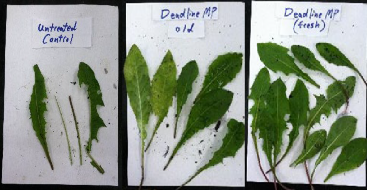
References
Clark, R. A., R. Youngman, A. Valoton, and R. B. Hammond. 2008. Slug management in continuous no-till. Virginia Coop. Ext. Pub. No. 2802-0000.
http://offices.ext.vt.edu/shenandoah/programs/anr/CropandSoilEnvironmentalSciences/Slug_Fact_ Sheet.pdf
Jordan, T. A., R. R. Youngman, and C. A. Laub. 2009. Slugs in Field Corn. Virginia Coop. Ext. Pub. No. 444-109. https://pubs.ext.vt.edu/444/444-109/444-109.html
Virginia Cooperative Extension materials are available for public use, reprint, or citation without further permission, provided the use includes credit to the author and to Virginia Cooperative Extension, Virginia Tech, and Virginia State University.
Virginia Cooperative Extension is a partnership of Virginia Tech, Virginia State University, the U.S. Department of Agriculture (USDA), and local governments, and is an equal opportunity employer. For the full non-discrimination statement, please visit ext.vt.edu/accessibility.
Publication Date
February 15, 2021



